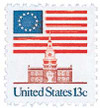
1975 13c Flag Over Independence Hall
# 1622 - 1975 13c Flag Over Independence Hall
$0.35 - $70.00
U.S. #1622
1975 13¢ Flag Over Independence Hall
1975-81 Regular Issue Stamp
1975-81 Regular Issue Stamp
Issue Date: November 15, 1975
City: Philadelphia, PA
Printed By: Bureau of Engraving and Printing
Printing Method: Engraved
Perforation: 11 x 10 ¾
Perforation: 11 x 10 ¾
Color: Dark blue, red and brown red
Independence Hall at the Old State House
Independence Hall, also known as the Old State House, is the most famous building in the historic city of Philadelphia, Pennsylvania. In fact, it can be considered the birthplace of the United States of America, as it has been the stage for many of the most important events in American history. It was constructed between 1732 and 1756, and has been restored several times to preserve its late-18th century appearance and style.
The list of historic events that occurred in Independence Hall is amazing. The Second Continental Congress met there in May 1775, and chose George Washington as commander in chief of the Continental Army. On July 4, 1776, the Declaration of Independence was signed in the Hall. In 1777, the design of the American Flag was agreed upon in the Hall. The Articles of Confederation were signed there in 1781. The United States Constitution was drafted within Independence Hall, and signed on September 17, 1787.
U.S. #1622
1975 13¢ Flag Over Independence Hall
1975-81 Regular Issue Stamp
1975-81 Regular Issue Stamp
Issue Date: November 15, 1975
City: Philadelphia, PA
Printed By: Bureau of Engraving and Printing
Printing Method: Engraved
Perforation: 11 x 10 ¾
Perforation: 11 x 10 ¾
Color: Dark blue, red and brown red
Independence Hall at the Old State House
Independence Hall, also known as the Old State House, is the most famous building in the historic city of Philadelphia, Pennsylvania. In fact, it can be considered the birthplace of the United States of America, as it has been the stage for many of the most important events in American history. It was constructed between 1732 and 1756, and has been restored several times to preserve its late-18th century appearance and style.
The list of historic events that occurred in Independence Hall is amazing. The Second Continental Congress met there in May 1775, and chose George Washington as commander in chief of the Continental Army. On July 4, 1776, the Declaration of Independence was signed in the Hall. In 1777, the design of the American Flag was agreed upon in the Hall. The Articles of Confederation were signed there in 1781. The United States Constitution was drafted within Independence Hall, and signed on September 17, 1787.













